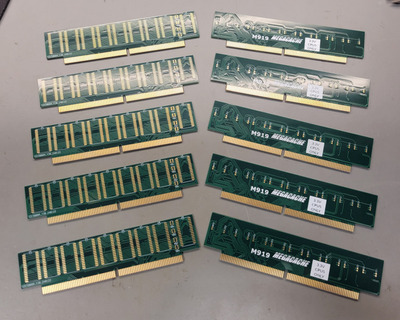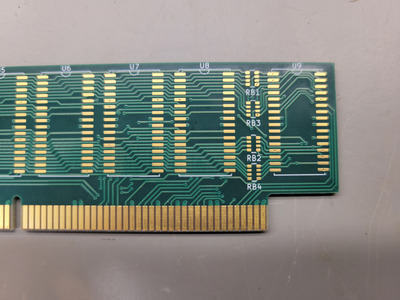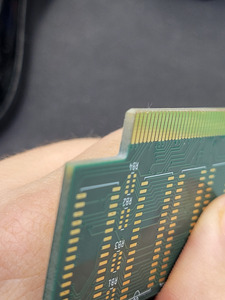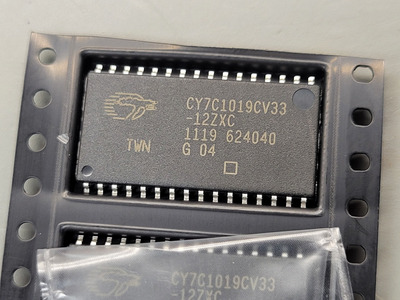Reply 100 of 115, by feipoa
- Rank
- l33t++
For anyone thinking of making their own M919 1024K modules and are looking for the IC's, I've done some testing you might be interested in. I tested the following SOJ and TSOP IC's in 8 ns and 10 ns speeds:
TSOP Cypress 10 ns
TSOP ISSI 8 ns
SOJ IDT white print 10 ns (western sourced)
SOJ IDT brown print 10 ns (China sourced)
SOJ ISSI 8 ns
SOJ Cypress 10 ns
SOJ IDT white print 12 ns (from pancakepuppy)
The results were:
failure = TSOP Cypress 10 ns
ok = TSOP ISSI 8 ns
ok = SOJ IDT white print 10 ns (western sourced)
ok = SOJ IDT brown print 10 ns (China sourced)
failure = SOJ ISSI 8 ns
failure = SOJ Cypress 10 ns
I don't understand why the font are different the between the pancakepuppy 12 ns units and the 10 ns piece I sourced. Note also that the IDT logo is missing on mine. Between the brown coloured IDT 10ns and white coloured IDT 10ns, the brown pieces have missing markers on the back.
I focused my testing primarly at 180 MHz, 2-1-2, 1/0 ws EDO DRAM read/write, and at 4.0 V. However, for the failures, I also tested at 133 MHz and 3.3 V to confirm it was't a voltage issue.
At 180 MHz testing on air (no peltier), I finally settled on the brown print IDT 10 ns chips for my cased system. I did not have the white print IDT 10ns at the time of this decision.
I did have trouble getting the TSOP ISSI 8 ns working reliably at 2-1-2, 1/0 ws, 180 MHz, 4V, 128 MB EDO. However, I retested them at 160 MHz, 2-1-2, 0/0 ws, at 3.3 V and 4.0 V, and there was no problem.
All IDT SOJ and ISSI TSOP pass at 160 MHz, 2-1-2, 0/0 ws.
Success at 180 MHz, 2-1-2, 1/0, 4V, 128 EDO depends largely on the EDO stick. I only have 1 in 4 that was happy with these tight timings.
In case anyone is looking, the ISSI 8ns TSOP chips are from aliexpress and the brown font IDT 10ns SOJ chips are from utsource. The white font IDT 10ns were sourced from Europe, but they look to be out of stock.
I settled on double-layer gold contacts for the M919 PCBs. Below, showing 12 ns IDT, 10 ns IDT, and 8 ns ISSI.
EDIT : Reminder :
Do not use exactly 64 MB DRAM on the M919. Your benchmarks will be low due to some strange bug. Use any amount other than 64 MB.
Plan your life wisely, you'll be dead before you know it.



